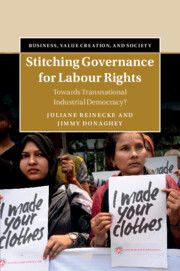Book contents
- Stitching Governance for Labour Rights
- Business, Value Creation, and Society
- Stitching Governance for Labour Rights
- Copyright page
- Contents
- Figures and Tables
- Foreword
- Foreword
- Acknowledgements
- Abbreviations
- 1 Introduction
- 2 The Democratic Deficit of Global Supply Chains
- 3 Democratic Representation
- 4 After Rana Plaza
- 5 Representative Alliances in the Creation of the Bangladesh Accord
- 6 Creating Representation through Industrial Democracy versus CSR
- 7 When Transnational Governance Meets National Actors
- 8 Building Representative Structures at the Workplace Level
- 9 Conclusion
- Book part
- References
- Index
2 - The Democratic Deficit of Global Supply Chains
Published online by Cambridge University Press: 09 March 2023
- Stitching Governance for Labour Rights
- Business, Value Creation, and Society
- Stitching Governance for Labour Rights
- Copyright page
- Contents
- Figures and Tables
- Foreword
- Foreword
- Acknowledgements
- Abbreviations
- 1 Introduction
- 2 The Democratic Deficit of Global Supply Chains
- 3 Democratic Representation
- 4 After Rana Plaza
- 5 Representative Alliances in the Creation of the Bangladesh Accord
- 6 Creating Representation through Industrial Democracy versus CSR
- 7 When Transnational Governance Meets National Actors
- 8 Building Representative Structures at the Workplace Level
- 9 Conclusion
- Book part
- References
- Index
Summary
The supply chain model has become the dominant mode of production in the globalised economy. While much attention has been placed on the downwards economic pressures of the model, little attention has been placed on the consequences for democratic participation. This chapter casts light on this area by examining how the supply chain model undermines democracy at work. It also raises the fundamental question of whether and how existing governance structures can be democratised, or whether and how new democratic institutions can be created that extend democratic underpinnings to globally expanding supply chains? Drawing on this we highlight that two distinct approaches to supply chain labour governance have emerged: one based on focussing on production relations and collective bargaining, and the other based on consumption relations and a CSR approach by brands. These approaches raise important questions that are central themes of the book such as what is the relationship between the representation of worker interests and consumer interests; who has the “right” to raise concerns about labour conditions in global supply chains; and can these contrasting approaches prove complementary?
Keywords
- Type
- Chapter
- Information
- Stitching Governance for Labour RightsTowards Transnational Industrial Democracy?, pp. 22 - 45Publisher: Cambridge University PressPrint publication year: 2023

